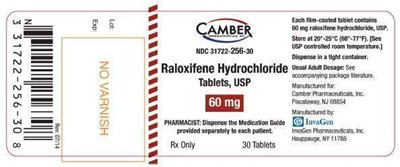Product Images Raloxifene Hydrochloride
View Photos of Packaging, Labels & Appearance
Product Label Images
The following 6 images provide visual information about the product associated with Raloxifene Hydrochloride NDC 31722-256 by Camber Pharmaceuticals Inc, such as packaging, labeling, and the appearance of the drug itself. This resource could be helpful for medical professionals, pharmacists, and patients seeking to verify medication information and ensure they have the correct product.
60mg-30 - 60mg 30ct

This appears to be a medication label or packaging information for Raloxifene Hydrochloride tablets. It includes instructions for storage of the medication, dosage information, and manufacturer information.*
table-1 - tab 1

This is a table displaying the adverse reactions reported during clinical trials for the medication Raloxifene Hydrochloride in comparison to a placebo group. The table is divided into sections based on the part of the body affected by the reaction. The reactions listed occurred at a frequency greater than 2.0% in those taking the medication. Some of the common reactions listed include headache, leg cramps, hot flashes, nausea, peripheral edema, and rhinitis. Some reactions are marked as occurrence in either group, others are not-marked, and others still have a letter code assigned to them (A or B) which presumably corresponds to the severity of the reaction. Overall, the table is difficult to interpret without additional context.*
Table-3 - tab3

This is a report on fractures diagnosed radiographically in randomized patients with Raloxifene Hydrochloride tablets. The report shows the number of patients with new vertebral fractures and symptomatic vertebral fractures in both the Raloxifene and placebo groups. The Relative Risk Reduction of the Raloxifene group was 30%. The Absolute Risk Reduction (ARR) for the new vertebral fractures and symptomatic vertebral fractures was 61% and 13%, respectively.*
Table-4 - tab4

This appears to be a table with various anatomical sites labeled alongside corresponding percentages and time intervals. The specific context or purpose of the table is unclear.*
* The product label images have been analyzed using a combination of traditional computing and machine learning techniques. It should be noted that the descriptions provided may not be entirely accurate as they are experimental in nature. Use the information in this page at your own discretion and risk.

